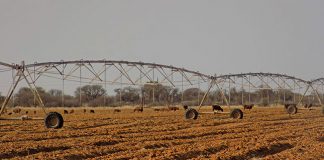It has come to light recently that R808,5 million of the national fiscus has been diverted from government departments for a presidential programme called the Masibambisane Rural Development Initiative (MRDI). I believe we must ask whether President Jacob Zuma is using the MRDI to gain support for his looming leadership battle. I also believe that the philosophy of the MRDI is based on the strategy followed by Mexico’s Partido Revolucionario Institucional (PRI) to trap voters in a relationship based on material dependence.
Providing support to win support?
The Ncora Irrigation Scheme in the Eastern Cape is part of the presidential programme. Ironically, it is a throwback to a 1970s apartheid project. The maize being harvested was planted by government on communal land. The plan is purportedly to transfer 20% of the proceeds to the community, while 80% is sold by government and used for reinvestment in the scheme for next year’s crop. However, there is no plan to indicate exactly how skills or revenue will be transferred to the community.
Last year, at the launch of a similar project in Nkandla near the president’s homestead, a senior department official voiced this concern. “It’s the old co-op system, and the big issue around co-ops is whether skills are created and the local farming community is empowered,” he said. Zuma is co-founder of the project and chair of the Masibambisane Trust, which manages the finances.
The bulk of the projects will be executed in the Eastern Cape, which is significant, as it is an area in which the president is struggling to maintain support against Deputy President Kgalema Motlanthe. Most concerning, however, is that the project depends on local chiefs donating land.
DAFF and Masibambisane
According to agriculture minister Tina Joemat-Pettersson, the MRDI is “an example of how government is getting to grips with what settlement support beneficiaries need and how all government departments need to work towards rural development”. It seems to have replaced her Zero Hunger Programme, but replies to parliamentary questions have shown that there is no business plan for this initiative. If anything, the project appears to divert more than R800 million from other government departments to aid Zuma’s Mangaung re-election efforts.
Joemat-Pettersson has repeatedly claimed that her department does not fund the programme at all. However, her reply to a parliamentary question indicates the skulduggery at play. She claimed that R286 000 in the department’s annual report was “inaccurately reflected as being paid to Masibambisane as an irregular payment”. “The fact is that the money was paid to three service
By invitation
Atholl Trollip, DA spokesperson for rural development, believes that President Jacob Zuma might be using the Masibambisane initiative to garner support for his upcoming party leadership battle. Is Zuma trading land for votes?
6 | farmer’sweekly | 14 DECEMBER 2012providers who assisted with the launch of a Masibambisane event, and no money was paid to the Masibambisane Rural Development Initiative, as I have often stated,” she said.
But in September last year, former official Steve Galane admitted that the department had pledged R10 million toward the initiative, and in September this year ex-spokesperson Selby Bokaba said the department had contributed R3 million to the programme.
Mexico – a bad example
Instead of following exemplary models of land reform, the ANC seems set on replicating the unfortunate Mexican trajectory. In that country, land reform – in the guise of communal tenure known as the ejido – was highly successful for mobilising electoral support for the PRI. But it came at a cost. It has been estimated that without it, Mexico’s economy might have been 124% larger than it is now.
In South Africa, it appears, too, to be ANC strategy to keep the rural poor in dependence by sticking with communal land tenure. It seems that Zuma will leverage this dependence through Masibambisane to secure electoral support in his bid to maintain leadership of the ANC.
Zuma’s efforts encapsulate the sentiment expressed by PRI founder Plutarco Elias Calles: “The ejido is the best means of controlling these people by simply telling them: if you want land you must be with the government; those who aren’t with the government won’t get land.”
Subsidy trap
Masibambisane-type projects mean that sustainable growth will suffer. Communal land, subject to arbitrary expropriation by the chief, cannot be sold, rented or used as collateral, and make the rural poor dependent on the state. In Mexico, thousands of farmers survived only because they received government subsidies. There are uncanny parallels with South Africa.
Contact Athol Trollip by emailing his PA, Amanda van Wyk, on [email protected]
The views expressed in our weekly opinion piece do not necessarily reflect those of Farmer’s Weekly.












